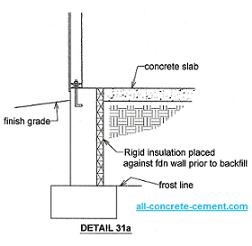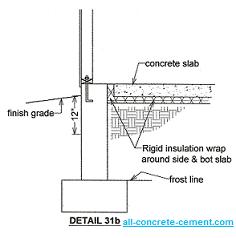|
[?]Subscribe To This Site
|
Insulated Concrete SlabInsulated concrete slab involves installing rigid insulations below the slab as a way to minimize the heat loss during cold winter months and cold loss during summer. These slab concrete insulation can also be used as concrete wall insulation as shown in three of the four details below. With the help of such underfloor insulation as rigid polystyrene, the concrete slab insulation or concrete slab heating is made possible and to be maintained thereby saving homeowners a lot from heat loss. Far too often concrete wall insulation is installed incorrectly such as shown on detail 31c. In this case the rigid insulation is being terminated below the slab in order for the concrete slab continues to the foundation wall. The absence of insulation between the bottom of the slab and the top of foundation wall, a distance of approximately 4 to 6 inches that span the entire perimeter of the house, is enough for a lot of heat loss to take place.

Detail 31d is a scenario where the bottom of the footing is at the frost line elevation. If the insulation starts on top of the footing heat loss can still take place below the footing. Should the footing is lowered by another footing depth, the insulation can then be started on top of footings as shown in detail 31a. Detail 31d is simply to show that the insulation needs to wrap around the footings should the frost line is at the bottom of the footing. 

When is insulated concrete slab needed is q question raised by many builders and homeowners. The answer is shown on detail 31b which is any floor slab that is within 12 inches of the finished grade, insulated slab is needed to minimize heat loss. Depending on how much area of the slab to be covered with rigid insulation, it will come down to the least expensive way to get the slab or foundation wall covered. Before choosing which detail to use, the number of rigid insulation sheets must be calculated based on details 31a, 31b, and 31d. The detail that yields the least amount of insulation sheets needed for the job wins. Note detail 31a may yield less rigid insulation sheets compared to 31d but 31a will require more concrete. This added concrete will also affect the formwork i.e. if det 31d wall height is 2ft, in comparison 31a wall height may be 2’-10”, depending on the footing thickness which is not standard for formwork. This will be a big deal simply because concrete forms are in 2ft increment. The labor for forming such wall can be as much as double, which is something that need to be considered. Back to insulated concrete slab |
|





